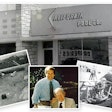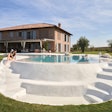
Consumers looking to buy a hot tub all have the same dream. They see themselves unwinding each night in perfect spa water — gentle on the skin, soothing to the muscles, clear and sparkling, clean and even fragrant.
But many potential spa customers are under the outdated impression that spa care is more like a nightmare — difficult and cumbersome. Fortunately, ongoing innovations have made spa chemical maintenance easier, ultimately translating into easy spa sales. These products are making it simpler than ever to overcome customers' use of the "it's too much work" objection.
Ease For Sale
All too often, spa owners used to rely on guesswork in their attempt to maintain proper pH and sanitizer levels, often meaning too much or too little of a particular chemical, resulting in an unpleasant experience.
"In the past there was not a program approach or a structure to spa care," says David Rouse, technical services manager for BioLab. "Customers would just add a sanitizer when needed, particularly when the water was cloudy, and add pH adjusters when the pH was out of balance. Not having a program or structure to spa care made spa maintenance confusing."
A spa care program is a set of daily, weekly and/or monthly guidelines that help the consumer regulate sanitizer, pH and alkalinity based on the individual's needs and lifestyle. It establishes a schedule for cleaning the waterline and chemically cleaning the filter. Numerous types of treatment, testing and troubleshooting products are helping consumers overcome yesterday's challenges and establish simple program approaches to spa chemical maintenance.
Chemical products are also coming in smaller, hot-tub-sized packages. "The formulations for spas are either being diluted or somehow scaled down, so you're not trying to measure miniscule amounts out of a big gallon pool bottle," says Michelle Mader, vice president of marketing at Earth Science Laboratories. Spa owners can be much more precise in maintaining the pH level, effectively avoiding scale formation and the buildup of bacteria.
In addition, to minimize the number of chemical applications, products are increasingly being packaged to accomplish more than one task. For example, they may remove oils, debris and metals all at the same time. The spa owner can then test the sanitizer, pH and alkalinity levels before and after applying chemicals, according to Rouse, with easy-to-use test strips.
Not only are chemical products making care easier, but the availability of additional resources is helping consumers learn about spa care and troubleshooting on the spot. "The best advances have been in our industry learning curve," says John Puetz, vice president of research & development for Advantis Technologies. "Today we are taking what we have learned and more and more effectively giving the consumer instruction guides that are much easier to follow." These user-friendly guides often include video instructions, CDs or DVDs. Manufacturer Web sites also provide a barrage of information and even allow customers to interact with technical staff or customer service personnel.
These resources may be wonderful tools, but retailers are ultimately responsible for making the customer understand from the outset that spa care is simple and that retailer support is always available. This information is beneficial to the customer but can also be a great selling point.
Lending A Hand
Part of the challenge of selling spas is that some potential customers are convinced that spa care is more trouble than it's worth. "I think the maintenance of [the hot tub] is the concern most people have," says Eric Roller, sales manager for Ft. Wayne, Ind.based retailer Olympia Pools & Spas. "They know they're going to enjoy the thing, but they also want to know that it's not going to be something that [they're] going to have to worry day in and day out about." Together the manufacturer and the dealer must help to alleviate these worries.
According to Puetz, manufacturers should provide dealers with easy-toread guidebooks that are catered to the consumer as a consumer, rather than as a chemist. The literature should include clear step-by-step instructions and emphasize simple maintenance program approaches.
But literature isn't enough. "[Dealers] need to rely on [manufacturers] for training, for product and technical support, whether it's a hotline or a Web site or something that can be referred to," says Mader. "And even sales support, too, to provide him with the point-of-sales material that encourages a spa owner to go with a particular chemical care line."
Retailers, in turn, must emphasize to customers the importance of some ongoing maintenance, even if it ends up being less than 15 minutes a week. Customers should understand the consequences of neglect and the importance of following directions closely and measuring chemicals carefully.
Bruce Rothschild, owner of the W. Melbourne, Fla.-based HotSpring Spas of Brevard & Indian River, stresses the importance of determining the best maintenance program based on the customer's interests and lifestyle. For example, he says, if someone is a nurse, he or she might be particularly concerned about bacteria, in which case Rothschild encourages the use of silver ion. Then he takes his customer through the procedure, step by step.
"We actually have a personalized sheet for them that explains what to do daily, what to do weekly, monthly," he says. "We literally have their name on it and what product they have, with the spa model, the size of the gallons and we personalize it at the delivery. We're showing people how easy we make it for them."
Most importantly, a dealer must be clear about his or her role — to provide support and answer all questions. "The last thing a retailer should do is tell a customer there is nothing to taking care of their spa," says Puetz. "There is. Just let the customer know the ease of care will come with the dealer's guidance. This will help keep the customer coming back."
To be successful in getting this message across, retailers should position themselves as experts. They should provide water testing and analysis, receive training through seminars and suppliers and offer help lines through the store. Mader suggests that dealers could even impress their customers by adorning their walls with training certificates and preparing customized spa care booklets.
These sales techniques, in addition to the impressive technology making spa chemical maintenance simpler, will help retailers sell more hot tubs and develop a stronger relationship with their customers.
"If spa care is difficult, then consumers won't want to buy spas," says Rouse. "They don't want to spend a lot of time cleaning them or balancing the water. They didn't buy a spa to become a chemist, either. Instead, they bought the spa to enjoy and relax. This is why a program approach, along with the expertise of the retailer/dealer is important to ensure the customer has a great experience with their spa."
And, in the end, everyone will be having pleasant dreams.
The Simple Life
Innovative technology brings consumers long way from guesswork.
To understand how far the industry has come since the days when spa owners dumped a bunch of chemicals in the tub while crossing their fingers, we can look at a few of today's products as exemplary of progress.
One such product is King Technology's Spa Frog Mineral Purifier. The Purifier comes in two main forms – the Floating System, which has a retail price of $39.95, and the In-line System, which is built into the plumbing and has a retail value of $100. The Spa Frog Mineral Purifiers implement a combination of minerals and bromine for a complete sanitization system, says Lynn Nord, marketing manager for King Technology.
The Spa Frog Mineral Purifier uses pre-filled cartridges that can meet the sanitizing needs of virtually any spa, according to the company. It provides an even output of minerals and bromine at all times, making the system more precise. The Spa Frog bromine cartridge only needs to be replaced every two to four weeks while the mineral cartridge will last up to four months.
Both the minerals and the bromine play an important role. The minerals are active on bacteria and absorb acids to keep the pH neutral. In addition, they decrease the amount of chlorine or bromine that's needed. The Spa Frog Mineral Purifiers actually use up to 80 percent less bromine than standard bromine spas. Bromine itself is less odorous, dissolves more slowly than chlorine, and when combined with the minerals, makes the water soft and clear, the company says.
"It's an easy program for [consumers] and they like how the water feels," says Nord. "Dealers have loved the floater. The packaging really stands out and it's easy to sell."
The Spa Frog Mineral Purifiers may dispense the appropriate chemicals, but ultimately the spa owner is still responsible for monitoring the water. A different product, BioQuest's BioFree System, is actually the first automatic spa water sanitization system able to both check the water and generate sanitizer as needed. A patented sensor measures the water sanitizer every 15 minutes and determines whether the water needs more chemicals. If so, it will dispense bromine and Oneshot, a specialty formula that eliminates chemical odors and cleans spa water. The BioFree System will also show the current status of the water on an LED display for the owner, alerting him or her to adjust the pH. "It's the closest thing that the industry has so far to a maintenance-free tub," says Mark Stephenson, president and chief executive officer for BioQuest.
With the BioFree System, consumers are only responsible for adjusting the pH before spa use and for draining the hot tub twice a year. With 2,500 systems in the field, BioQuest has already introduced a brand-new system, the BioFree Plus, that it says produces bromine 2times faster. This means that after the spa is used heavily, it will recover 2- times faster. And according to Stephenson, the technology will continue to get smaller, cheaper and even more reliable and precise.
— L.R.M.
Au Naturel
Company uses crustacean waste to make a spa care alternative.
Companies around the nation recycle the usual material every day — glass, plastic, paper and aluminum. But one company, Vanson HaloSource, prefers to recycle something a little different — natural crabshell chitosan.
According to Terry Arko, product technology manager for Vanson HaloSource, when a crustacean is processed for seafood, 80 percent needlessly goes to waste. This waste includes chitosan, the carbohydrate that acts as glue, keeping the shell material together.
Vanson HaloSource uses this waste to create, among other product lines, Sea-Klear, one example of a line of spa and pool chemical products that is safe for the environment and that makes pool and spa care easy and efficient.
The competitively priced Sea-Klear can offer an answer to customers seeking alternative spa chemical maintenance systems. The waste used to formulate Sea-Klear is not taking up space in a landfill or being dumped into a body of water. Sea-Klear is not manufactured with the use of petroleum. Finally, when spa owners drain their hot tubs, they don't have to wait for the chemicals to break down before it's safe to release them into the environment — Sea-Klear products are biodegradable and completely harmless to plants, animals and fish. They are so harmless, in fact, that Sea World and zoos around the nation use them.
"We found in dealerships that have our Sea-Klear product, there's an 87 percent return rate of people who come back specifically for that brand of product because of the naturalness and because of the effectiveness of it," says Arko.
In addition to being OK for the environment, the company says Sea-Klear products were developed to make spa care simple. The Natural 4-in-1 Clarifier, for example, does four things at once to make the spa owner's life easier: 1) It removes organic debris to keep the water clean; 2) removes excess oils that lead to maintenance problems; 3) removes metals that can stain the tub and 4) acts as a filter aid, actually enhancing the ability of the filter.
Because the Natural 4-in-1 Clarifier is not synthetic, the spa owner does not risk damage to the hot tub if he or she uses too much of it. Minimally, it only has to be applied once a week.
"When I sell it, I use it as a prevention product," says Sarah Spaulding, store sales manager for Seattle-based Johnson Spa, Stove and Patio. "I think people are more about prevention than spending all of this money on fixing an issue."
— L.R.M.






































